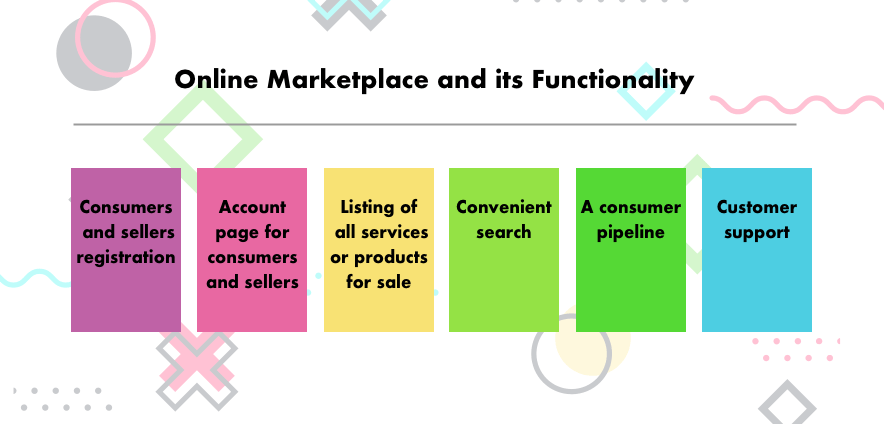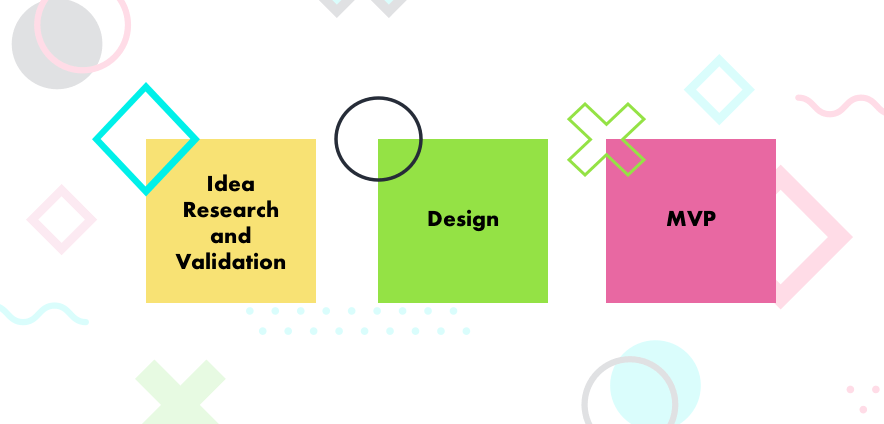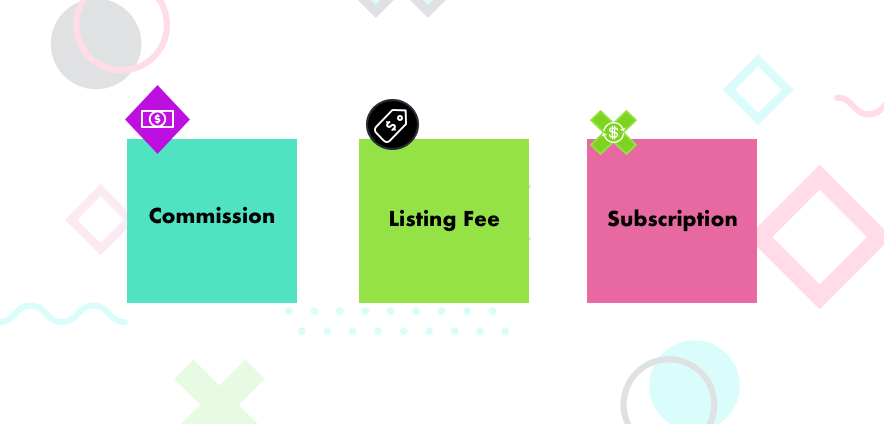Recently updated on May 21, 2024
Do people still build online marketplaces? Hell yeah, they do. More than half of all online marketplaces were launched in the last 7 years. The market continues to grow, people are more willing to buy and sell, online, new countries enter the level of economic prosperity that is just right for online marketplaces. The opportunities are ripe to harvest, and the proper reliable online marketplace will allow you to do it efficiently. Besides, the last thing the market needs is a handful of giant corporate mega players of online retail platforms dictating all the rules. Fresh blood is absolutely required to give a new impulse to the sector, introduce new features, and attract a new audience. If you want to become this fresh blood and create your own online marketplace, this article is for you.
It will guide you through the basic knowledge required to lead online marketplace creation, describe its functionality, provide some examples and ways of monetization.
Content:
1. Online Marketplace and its Functionality
2. Examples of Online Marketplaces
3. Things to Know to Create an Online Marketplace
4. How Does Online Marketplace Make Money?
5. Conclusion
Online Marketplace and its Functionality
Online marketplaces are digital platforms that aggregate product makers and service providers and allow people to buy products or services online. Such marketplaces come in a huge variety. Be it Uber that allows individuals to sell their driver service; Etsy that provides renters with the possibility to sell their creations; Airbnb that allows house owners to rent their property to other people; or Fiverr where users can sell whichever relevant services they can provide — all of them are online marketplaces. An entrepreneur who is willing to start an online marketplace business will be greeted with a wide spectrum of options to choose from.

Any online marketplace has two essential parts: the admin panel and the user side. The admin panel is a control panel of the marketplace. A marketplace is managed using an admin panel. The latter helps to manage inventory, orders, payments, customers, and a bunch of settings required for the proper functioning of the online marketplace. The admin panel determines the efficiency with which you can manage a marketplace. If the panel is of low quality or isn’t user-friendly, you will face a lot of challenges, rigid workflow, and unpredictable bugs, which may result in irreparable damage.
You also may be interested in our portfolio or:
The user side is a ‘face’ of a marketplace. It is a two-fold piece as well. On one hand, it is used by customers to interact with the marketplace: make their orders, communicate with sellers, leave reviews, etc. On the other hand, the user side is for product creators and service providers. Intuitiveness, appealing design, and relevance of the user side are among the major determiners of the commercial success of a marketplace. The user side is where the most features, which are common to marketplaces, reside. A well-rounded online marketplace should have the following user functionality:

– Registration forms for both consumers and sellers
– Account page for consumers and sellers with all relevant information and managing capacities (shopping cart for buyers, reviews for sellers, etc).
– A marketplace itself, which is a listing of all services or products for sale, which can be sorted by price, category, location of service providers, etc
– Convenient search for navigating the marketplace
– A consumer pipeline, which leads a buyer from ordering a product to shipping (secure online payments, communication with a seller, shipping options)
– Customer support
Additional functionality is a topping on the cake, which can make a marketplace more attractive for a certain audience or more intuitive and pleasant to use overall.
Examples of Online Marketplaces
The variety of online marketplaces is impressive. So, we better dissect a couple of them to better understand the industry.
Etsy
Etsy is a bright example of a niche marketplace, which made a lot of noise and a lot of success. The marketplace is aimed at vintage and handmade items. In 2018, Etsy had almost 40 million users and more than 2 million sellers. These numbers are impressive even if we forget that Etsy is a niche marketplace.
Etsy has a strong focus on promoting its creators and craftspeople. By driving the personal brands of their creators through publications and proper marketing, Etsy boosts its performance as well. The marketplace demonstrates a proper symbiosis between providers and the aggregator.
Airbnb
Unlike Etsy, Airbnb is a renting service. With the help of Airbnb, landowners can conveniently rent their houses to people for short periods of time. Airbnb is the most popular among tourists and people who travel a lot as the service offers a huge spectrum of housing for any wallet and taste. As a user, you can choose a house within a certain location in a certain city for rent from a range of various options. Airbnb has good quality control and a solid review system that allows the service to weed out irresponsible house owners and renters.
Airbnb hit the housing market like a storm disrupting the rental business, especially in tourist-heavy areas.
Things to Know to Create an Online Marketplace
Any piece of software starts with an idea. Though, if you want to build an online marketplace, the idea ‘I want to build an online marketplace’ is not a sufficiently solid foundation. The idea is a much deeper concept here, which should involve a lot of research, consideration, doubts, and testing. A solid idea should answer the following questions:
– What problem will my marketplace solve?
– What is my niche?
– How will I attract buyers and sellers to my marketplace?
– What benefits will the marketplace have over competitors?
– Where the starting point and will the marketplace be able to scale sufficiently?
– What are the market regulations?
– How will I monetize the marketplace?
Therefore, the first step on the path to making an online marketplace is

Idea Research and Validation
Ideally, this stage involves a team that consists of software developers, QAs, and business analysts who can conduct thorough research to determine everything mentioned above as well as choose the most appropriate technologies for the development of the marketplace. With all the information in place, you can move on with the marketplace creation.
Design
Now, you have the basics required to create the design of a future product. It requires closer research of a user to better understand its pains and needs as well as close evaluation of the market standards in order to provide relevant and intuitive UI/UX of the future product.
MVP
After all the data is gathered, you will have everything required to build a Minimum Viable Product. MVP is an important step because it allows to test the concept with real users and receive feedback, which is absolutely necessary for further development. MVP is also a great option for a limited budget because it can help obtain additional funding. Development of the MVP is a separate story that involves a variety of iterations each of which requires planning, development, and testing to achieve the best results.
How much does it cost to develop an Online Marketplace?
The cost to build an online marketplace varies widely depending on the complexity of the system, a platform it should be developed for (iOS, Android, Web, or all of them), the stage of the idea’s development, and the price policy of a company responsible for the development. Overall, if you roll with the in-house team, the costs are more likely to be higher than when you chose the nearshore software development option considering the overhead costs and the price of local labor. Nonetheless, the surest way of determining the price is to conduct the cost estimate. The accuracy of the cost estimate varies as well depending on the thoroughness of the research, presence of deliverables, and the experience of the team performing the estimate.
If the only thing you have is an idea, here at Kindgeek, we consider the Discovery Phase to be the best option that will give you an accurate cost estimate as well as deliverables, which are a solid foundation for further development.
Depending on a chosen package the Discovery Phase provides you with the following
– product concept from Product Manager
– prototypes from Business Analyst
– a visual concept from UI/UX Designer
– architecture concept from System Architect
– estimates of development costs
If the budget is tight, they can help you to attract new audiences and investments required for the next steps of the development process.
How Does Online Marketplace Make Money?
There are several major ways to make money out of an online marketplace.

Commission
The most prevalent and, perhaps, the most profitable way of making money out of an online marketplace. Commission means that you get a percentage of each product or service that’s been sold using the marketplace. The commission may vary depending on the type of product or service. A commission can also be a flat fee or a percentage. This monetization model offers some flexibility too. For instance, you can charge buyers, sellers, or both buyers and sellers but with a smaller fee.
Listing Fee
If a marketplace allows a seller to benefit more the more items he or she has for sale, then the listing fee can be an answer. Listing fee charges sellers a small amount for each product or service listed on a marketplace.
Subscription
A marketplace that is unique and provides an excellent service with exclusive guarantees and features can adopt a paid membership monetization model. It means that you will charge users for using the service. Building a solid customer-base may prove difficult with this model though. However, exclusive features and proper marketing can do the job.
We also want to mention freemium here because it’s similar to a subscription model. However, freemium means that the general functionality and features of a marketplace are free, while the extra ones go for a subscription fee.
What about the advertisement you ask? The advertisement may drive some revenue, but it will not be enough to cover any major expenses. An online marketplace is a maintenance-heavy project, so we do not consider advertisement a sufficient way of monetization. Therefore, treat ads revenue as ‘pocket money,’ which can be used for some minor needs. Overall, to choose the best option of monetization, thorough research is required as each marketplace has its specifics.
Conclusion
If you are to build an online marketplace website or create an online marketplace like Etsy, you will face a bunch of business and software development-related challenges. However, a relevant marketplace can be a lucrative and demanded piece of software with a huge capacity for scaling. If you don’t want to experience the hustle of hiring, supporting, and managing an in-house team, finding a reliable tech partner to help you build a marketplace is a vital step.
With experience in building eCommerce as well as FinTech projects, Kindgeek can become your partner and help you to develop a reliable and secure online marketplace as well as provide business analysis expertise.




